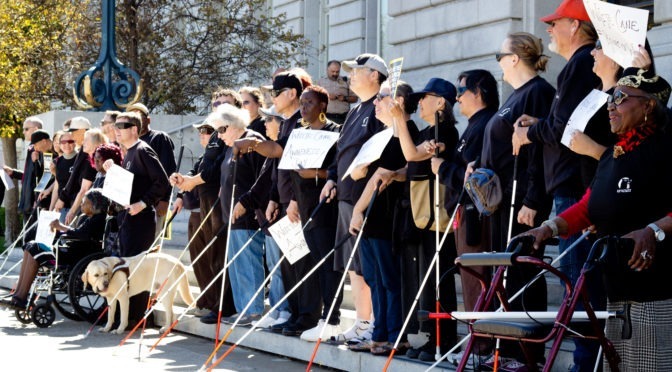On October 15, 1964, President Lyndon B. Johnson declared the first-ever White Cane Safety Day in the United States. Later, in 2011, President Barack Obama declared October 15 as Blind Americans Equality Day. This year, on Sunday October 15, LightHouse is celebrating White Cane Day by walking across the Golden Gate Bridge with approximately 200 members of the blind community and our allies! But what really is White Cane Day? And what does it mean to be visually impaired and use a white cane?
Here is some White Cane insight from our LightHouse Staff:
“I have been a proud traveler with my white cane for about 50 years. I love to walk. My white cane is an amazingly simple tool that empowers me to independently explore and experience my environment. You might say that October 15, White Cane Day, is my personal independence day. My proudest use of my white cane was to walk independently along every segment of California’s El Camino Real, from the Millbrae BART station, to the California Street Caltrain station near Stanford University in Palo Alto, all during the 13 years that I resided in San Mateo County. Someday, I hope to traverse the entire San Francisco Bay Trail on foot with my cane or guide dog. That’s what independence looks like.” – Frank Welte, Senior Accessible Media and Braille Specialist
“My white cane is my right of way. If it is used correctly, the long white cane alerts drivers, it detects obstacles and it clears the crowd. I use various types of long, white canes in different environments. For example, I use a lightweight cane in familiar indoor settings such as my workplace; I use a heavy-duty cane with a roller tip for San Francisco streets, and I have a spare ID cane that is always packed in my backpack when I’m out and about. In addition to the many benefits the white cane provides, I do not have to explain myself when I request a pre-boarding on a plane. The white cane gives me the privilege of getting first in line for amusement park rides or at concerts I attend with family and friends, which they love me more for it. I call it the ‘VIP’ treatment, which I define ‘VIP’ as ‘Visually Impaired Person’ or for others, ‘Very Important Person.’ Either way, I’ll take both!!” – Divina Carlson, Braille Instructor
“When I was a boy in Pennsylvania, I used to carry a long aluminum tube with me when I went walking in the woods near our house. I would poke it into holes in the ground, reach up into trees, and blow bubbles in the creek. I had fun with it! When I was first introduced to the white cane at a Changing Vision Changing Life workshop at Enchanted Hills Camp, I felt a little surge of recognition, and said to myself, ‘I can make friends with this cane!’” – Jeff Buckwalter, Access Technology Specialist
“I was diagnosed with Stargardts Retinal Disease when I was 14 and received my first white cane when I was 18. With my level of low vision, my cane is not a tool I use daily, but it has been there for me when I’ve needed it most. I love to travel, but reading street signs, informational screens, or directional signals is very difficult–especially when I’m navigating my way through a new city or crowded airport. This is when my trusty white cane comes into play. When I travel with my cane, I have the confidence to approach people to ask for help or directions. My cane indicates to others that I have low vision, so rather than point their finger into an abyss of blur and confusion, I am often given descriptive and helpful directions or assistance. My cane also acts as a reminder to the sighted world that blind people can be as independent as any other person.” – Caitlin O’Malior, Communications Specialist
Here’s some White Cane Tips (pun intended) from LightHouse Orientation & Mobility Specialists:
Dakota Disk Cane Tip
Going to the beach with your cane? Worried about sand getting stuck in your roller tip? Try out the Ambutech Dakota Disk Cane Tip, made of light, durable plastic that easily moves over uneven ground. It gets its name from the state in which it was designed, North Dakota, and also works well in snow, slush, mud, and grass. (It’s not designed for prolonged use on cement.)
Roller Ball Tip
The roller ball tip is made of nylon and has a bearing on the inside which allows it to rotate left to right and measures about two inches in diameter. Due to the size of this cane tip, it tends to roll over rocky and uneven terrains well.
Jumbo Roller Tip
The jumbo roller cane tip is disc-shaped, resembling a semi-flattened marshmallow, with a build-in protected bearing and rounded outer edge designed to roll left to right. The tip is made from ultra-high molecular weight polyethylene material and is about 2.5 inches in diameter. This tip rolls over rough terrain and does a good job on grass as well.
All white canes and white cane accessories are 10% off at our Adaptations Store through the end of October.

